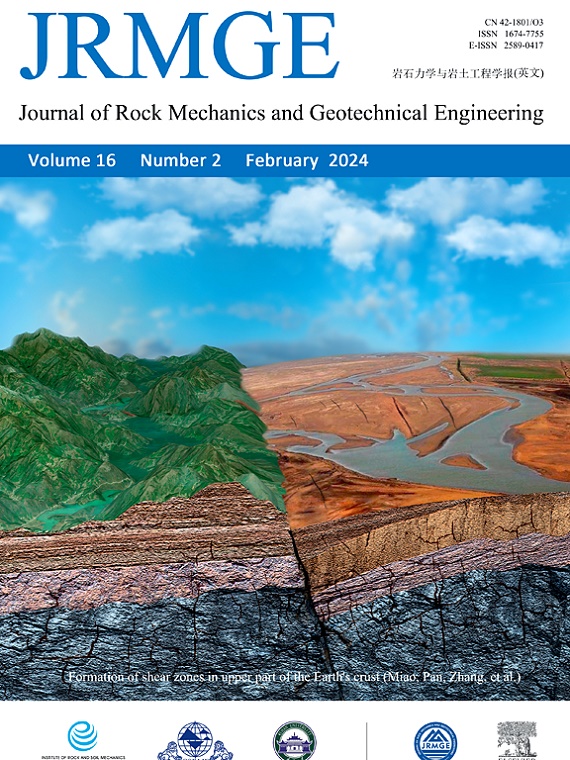Damage constitutive model of lunar soil simulant geopolymer under impact loading
IF 10.2
1区 工程技术
Q1 ENGINEERING, GEOLOGICAL
Journal of Rock Mechanics and Geotechnical Engineering
Pub Date : 2023-11-01
DOI:10.1016/j.jrmge.2023.04.025
引用次数: 0
Abstract
Lunar base construction is a crucial component of the lunar exploration program, and considering the dynamic characteristics of lunar soil is important for moon construction. Therefore, investigating the dynamic properties of lunar soil by establishing a constitutive relationship is critical for providing a theoretical basis for its damage evolution. In this paper, a split Hopkinson pressure bar (SHPB) device was used to perform three sets of impact tests under different pressures on a lunar soil simulant geopolymer (LSSG) with sodium silicate (Na2SiO3) contents of 1%, 3%, 5% and 7%. The dynamic stress–strain curves, failure modes, and energy variation rules of LSSG under different pressures were obtained. The equation was modified based on the ZWT viscoelastic constitutive model and was combined with the damage variable. The damage element obeys the Weibull distribution and the constitutive equation that can describe the mechanical properties of LSSG under dynamic loading was obtained. The results demonstrate that the dynamic compressive strength of LSSG has a marked strain-rate strengthening effect. Na2SiO3 has both strengthening and deterioration effects on the dynamic compressive strength of LSSG. As Na2SiO3 grows, the dynamic compressive strength of LSSG first increases and then decreases. At a fixed air pressure, 5% Na2SiO3 had the largest dynamic compressive strength, the largest incident energy, the smallest absorbed energy, and the lightest damage. The ZWT equation was modified according to the stress response properties of LSSG and the range of the SHPB strain rate to obtain the constitutive equation of the LSSG, and the model's correctness was confirmed.月球土模拟地聚合物冲击载荷下的损伤本构模型
月球基地建设是月球探测计划的重要组成部分,考虑月球土壤的动态特性对月球建设具有重要意义。因此,通过建立本构关系来研究月球土的动力特性,为月球土的损伤演化提供理论依据至关重要。本文采用分离式霍普金森压杆(SHPB)装置对硅酸钠(Na2SiO3)含量分别为1%、3%、5%和7%的月球土壤模拟地聚合物(LSSG)进行了三组不同压力下的冲击试验。得到了不同压力下LSSG的动态应力-应变曲线、破坏模式和能量变化规律。基于ZWT粘弹性本构模型对方程进行了修正,并与损伤变量相结合。损伤单元服从威布尔分布,得到了能够描述动荷载作用下LSSG力学性能的本构方程。结果表明,LSSG的动态抗压强度具有明显的应变率强化效果。Na2SiO3对LSSG的动态抗压强度既有强化作用,也有劣化作用。随着Na2SiO3的增大,LSSG的动态抗压强度先增大后减小。在固定气压下,5% Na2SiO3的动态抗压强度最大,入射能量最大,吸收能量最小,损伤最轻。根据LSSG的应力响应特性和SHPB应变率范围对ZWT方程进行修正,得到LSSG的本构方程,并验证了模型的正确性。
本文章由计算机程序翻译,如有差异,请以英文原文为准。
求助全文
约1分钟内获得全文
求助全文
来源期刊

Journal of Rock Mechanics and Geotechnical Engineering
Earth and Planetary Sciences-Geotechnical Engineering and Engineering Geology
CiteScore
11.60
自引率
6.80%
发文量
227
审稿时长
48 days
期刊介绍:
The Journal of Rock Mechanics and Geotechnical Engineering (JRMGE), overseen by the Institute of Rock and Soil Mechanics, Chinese Academy of Sciences, is dedicated to the latest advancements in rock mechanics and geotechnical engineering. It serves as a platform for global scholars to stay updated on developments in various related fields including soil mechanics, foundation engineering, civil engineering, mining engineering, hydraulic engineering, petroleum engineering, and engineering geology. With a focus on fostering international academic exchange, JRMGE acts as a conduit between theoretical advancements and practical applications. Topics covered include new theories, technologies, methods, experiences, in-situ and laboratory tests, developments, case studies, and timely reviews within the realm of rock mechanics and geotechnical engineering.
 求助内容:
求助内容: 应助结果提醒方式:
应助结果提醒方式:


